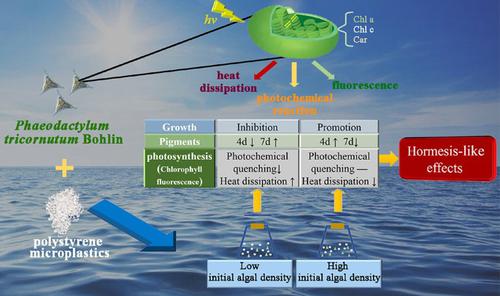Frontiers of Environmental Science & Engineering ( IF 6.4 ) Pub Date : 2021-06-11 , DOI: 10.1007/s11783-021-1436-0 Zuyin Chen , Lihua Li , Lichong Hao , Yu Hong , Wencai Wang

|
The effects of pristine polystyrene microplastics (pMPs) without any pretreatment at different concentrations (0, 10, 20, 50, and 100 mg/L) on Phaeodactylum tricornutum Bohlin at two initial algae densities (105 and 106 cells mL) were assessed in this study. Hormesis-like effects were found when microalgae grew with pMPs. The results showed that pMPs inhibited microalgae growth under a high concentration of microplastics tolerated by individual algal cell (low initial algae density) (up to −80.18±9.71%) but promoted growth when the situation was opposite (up to 15.27±3.66%). The contents of photosynthetic pigments including chlorophyll a, chlorophyll c and carotenoids showed resistance to pMPs stress under a low initial algae density and increased with time, but the opposite was true under a high initial algae density. Compared with the low initial algae density group, Qp received less inhibition, and NPQ (heat dissipation) also decreased under the high initial algae density. Under the low initial algae density, OJIP parameters such as Sm, N, Area, Pi Abs, Ψo, φEo, TRo/RC and ETo/RC were more perturbed initially and returned to the levels of the control group (without pMPs) over time, but they remained stable throughout the experiment at high initial algae density. These results show that microplastics in the marine environment may have different toxic effects on P. tricornutum at different growth stages, which is of great significance for understanding the impact of microplastics on marine microalgae and aquatic ecosystems.
中文翻译:

暴露于聚苯乙烯微塑料的海洋硅藻三角褐指藻 Bohlin 的刺激样生长和光合生理学
在两种初始藻类密度(10 5和 10 6)下,未经任何预处理的原始聚苯乙烯微塑料 (pMPs) 在不同浓度(0、10、20、50 和 100 mg/L)对三角褐指藻Bohlin 的影响在本研究中评估了细胞 mL)。当微藻与 pMP 一起生长时,发现了类似兴奋剂的效应。结果表明,在单个藻类细胞耐受的高浓度微塑料(低初始藻类密度)下,pMPs抑制微藻生长(高达-80.18±9.71%),但在相反情况下促进生长(高达15.27±3.66%) . 叶绿素a、叶绿素c和类胡萝卜素等光合色素含量在低初始藻密度下表现出对pMPs胁迫的抗性,并随时间增加,而在高初始藻密度下则相反。与低初始藻密度组相比,Qp受到的抑制较小,并且在高初始藻密度下NPQ(散热)也下降。在低初始藻密度下,OJIP 参数如 Sm、N、Area、Pi Abs、Ψ o、φ Eo、TRo/RC 和 ETo/RC 最初受到更多干扰,随着时间的推移恢复到对照组(没有 pMPs)的水平,但它们在整个实验过程中保持稳定高初始藻类密度。这些结果表明,海洋环境中的微塑料可能对不同生长阶段的三角褐指藻产生不同的毒性作用,这对于了解微塑料对海洋微藻和水生生态系统的影响具有重要意义。


























 京公网安备 11010802027423号
京公网安备 11010802027423号